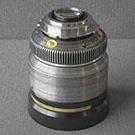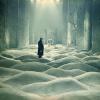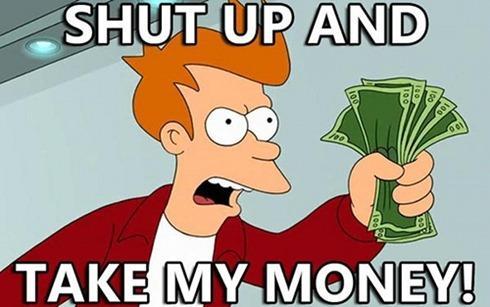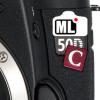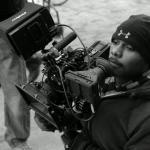Leaderboard
Popular Content
Showing content with the highest reputation on 01/14/2013 in all areas
-

APS-C and Super 35mm just went full frame - Metabones Speed Booster
Sean Cunningham and 2 others reacted to /p/ for a topic
3 points -
The reason is enlargement ratio. There is always a degradation of image quality when enlarging an image. The smaller the sensor, the more times an image must be enlarged to make the display size. Example. MFT has to be enlarged about 10 x to print an 8x10. A Full frame sensor only has to be enlarged about 5 times. This means that the larger sensor will be able to hide more defects than a smaller sensor, because it has been enlarged so much. My wife as recently watching an American Civil War documentary and commented on how clear the images were for being taken 150 years ago. I explained to her that most of these prints were contact prints, with no enlargement taken on 8"x10" film. Larger sensors will always have a greater quality to them, however, this prevents the camera from "wasting" all the information that was just thrown away before, by focusing the full frame image onto a crop sensor. A better way to think about this for those who understand anamorphic, is that an anamorphic lens makes you lens wider by compressing a very wide image onto the sensor, so no image is lost (cropped) the allows you to use a longer lens. Mine is on order2 points
-

Blackmagic Cinema Camera gets a rival - Dan Chung shows us the KINERAW MINI
gebybaidway reacted to Andrew Reid for a topic
In a sea of insipid and faceless cameras for the corporate workplace, here is something different. Like the Blackmagic Cinema Camera it is designed for filmmakers who want image quality as close to Super 35mm film as possible but can't afford $15,000+ This is rumoured to be around the $4000 mark and has a Super 35mm sensor, Cinema DNG raw recording and a very compact body with no fan.1 point -

Night Call Round Rock (GH2 Anamorphic)
nahua reacted to Sean Cunningham for a topic
https://vimeo.com/573064241 point -
APS-C and Super 35mm just went full frame - Metabones Speed Booster
andy lee reacted to tony wilson for a topic
do not purchase straight away i guarantee already in china someone is copying the prototype. within 3 months 5 different versions will be on the market. as the china sharks copy and feed off each other the price collapses. metabones will have the better engineering but a crap copy for 90 dollars who will turn that down. who knows the copy might come from the same massive factory as the original.1 point -

APS-C and Super 35mm just went full frame - Metabones Speed Booster
Orangenz reacted to Andrew Reid for a topic
It wouldn't be M43 to M43 that would be impossible! This takes a FULL FRAME lens and reduces it down, giving you a brighter image as a side-effect. It can also take an APS-C lens and reduce that down to M43. If you take a M43 lens and reduce it down you will have black edges to the image Powderbanks. Also focus would be completely broken.1 point -

Ideal settings for GH3? (color grading and a first example)
nahua reacted to powderbanks for a topic
personally, i'm not a big fan of the warp stabilizer. it can end up causing some really weird warping and jelloing (which technically i suppose is working correctly, but i don't like it) in more shots than expected; if i need to do some stabilization i like using the motion tracking in AE. but that's kind of moot since OP is using final cut. 1) it is and it isn't a 'lesser' HD. the difference is in the ipb frames, frame rate and bitrate. the all i hd mode means every frame at 24fps is its own individual 'picture,' whereas other modes there are predicted frames between the keyframes. this allows more compression of the video. for the most part, it's hardly noticeable, especially at 60fps. frame rate, 24fps vs 60fps, pretty obvious. if you take your 60fps footage and conform it to 24fps, you have some really nice ~40% slow motion. and with the lower bitrate as well, as nahua said, it will take up less space on your memory card (helpful for #4). 2) it looked like there was a little bit of banding in the opening fade in from inside the tent. though i think it was only exacerbated by the fade in. 3) i shoot with a gh2, but i have the noise reduction as low as possible, no matter what i'm shooting. if i get into the higher iso's, i just make sure i use a faster lens (or add lights to the scene if i can) to help lessen the amount of noise in the darker areas of the image. and if i go the whole way to 12800, the only way to make it really usable is to shoot it in b&w; and even then, bumping up the NR does very little. 4) the image flatness/color profile should remain near enough the same between the AVCHD and h.264 video1 point -

Light Meter Use - a poll
nahua reacted to QuickHitRecord for a topic
Funny to see this post as I placed an order for a Gossen Digisix 2 last week. Up until now I have only been using a waveform to monitor exposure, but the ability to light a scene before the camera even shows up is invaluable to me. Also, I can match contrast ratios for consistency across a project. I'm really looking forward to getting it.1 point -
Century Optics Pro Series HD 0.7X WIDE ANGLE CONVERTER for Sony HDV front element glass is 82mm rear is 60mm 72mm with the bayonet mount Its big heavy and stunningy sharp!! and makes your 50mm full frame into a 35mm full frame equivilent I use it on my Tecnoir Cinema Rig supporting it using a clamp and rails there is one on ebay here http://www.ebay.co.uk/itm/Century-Precision-Optics-0-7x-Wide-Angle-Converter-Lens-f-Sony-HDR-FX1-HVR-Z1U-/230903460835?pt=LH_DefaultDomain_0&hash=item35c2eb33e31 point
-
APS-C and Super 35mm just went full frame - Metabones Speed Booster
Sean Cunningham reacted to Matt for a topic
Just read the write up on Philip Bloom's site. If you read the comments you get Canon owners asking if they can use it with their Canon lenses. Bless em!1 point -
APS-C and Super 35mm just went full frame - Metabones Speed Booster
Orangenz reacted to jessekorgemaa for a topic
For the record, a 24-70 2.8 does not suddenly become a 24-70 1.8. It gives you the same look as a 24-70 2.8 on FF. So more like 18-50 1.8 or whatever the math would be. a 50mm does not become a 35mm, it just acts as a 50mm is menat to act. This is a pretty interesting product though, hopefully they can make more mounts. We can pretty much leave math out of it and pretend you have FF sensor, much easier.1 point -
This is a really exciting product, however... there are a lot of posts getting excited about using all sorts of cheaper lenses. But from what I see the adapter will turn your cam into an ef mount, alpha mount or leica r mount. You are then going to have to adapt your FD or what ever legacy lens to one of those 3 mounts. Not so easy and not so straight forward as many need extra glass for infinity focus and finding good ones is more difficult. Also you then have 2 adapters, and possibly more 'play' in the lens mounting. I have several canon FD lenses and would love to have them at full frame equivalent on m43, but I'm not sure the current road map for this gives me what I need. I hope I'm wrong. But this may not be aas good for legacy lenses as it seems at first. Also I don't think it will make f2.0 into f1.4 lens. It will give the equivalent brightness of a f1.4 due to conentrated image, but not change the dof characteristics, surely it will still give the original characteristics of the lens. dof will be as f2.0. When the website talks about .71wider it is talking about .71 wider on a s35, which brings the lens back to 50mm full frame, so when it talks about 1 stop increase in apeture, again bringing it back to FF equivalent?? So will this mainly be for current lenses(ef etc) or can we use legacy glass?1 point
-
Having a little hand held meter which you can use to check every element in frame while the camera is locked down I imagine would be really nice. I don't own a light meter but am planning a purchase for use in a film I am writing. when using a camera with limited dynamic range that needs scenes lit properly I think it will be an invaluable addition when lighting a scene.1 point
-
Generally Light Meters are used because misjudging an exposure on film would be very costly. When you're shooting with a bunch of friends or on a low budget set with a prosumer digital camera it's not such a big deal. No need to waste hours during a shoot checking those values. I'm not saying it's a bad thing, but a lot of DP's don't use Light Meters because they aren't always necessary, especially when you know your camera well enough.1 point
-
Yes, it's a language thing... of course it doesn't physically change the lens, but you get exactly the same image you would get with a wider lens. By extender I mean a teleconverter (which also works with the light exiting), which works the same but the other way around. @Richg101: Yes indeed. Extra speed, better quality in theory (downscaling the lens faults) and same dof as on fullframe. Just imagine the exact opposite effects of a 1.4x extender.1 point
-
hence all the unbelievable lens figures in m4/3 mount. Wides with nuts fast apertures. Now it makes sense how they actually do this.1 point
-
I remember we were chatting a long while back about these, I remember at the time there was some kind of patent -- maybe Eastman Kodak -- that meant no-one could make them, so I'm glad this has been worked around. Maybe the Isco/Schnieder patent can too... Although many find it hard to believe all the research I've done shows there's no significant downsides to this technology. It's actually used INSIDE some premium M4/3 lenses at the moment, with established F2.8 designs incorporating an optical reducer in order to give a nice field of view for the crop sensor and bump up the F-stop. I'dve though the only downside will be that with some lenses the corners will remain the same, while only the centre will be sharper. Not much of a downside. It's a bit like scaling down footage shot on a soft camera, suddenly it's much sharper than before...1 point
-
Why I think Canon have forgotten the indie filmmaker
Xiong reacted to ScreensPro for a topic
Ridiculous statement. We are talking about image making machines. Not narrative film cameras. Do you think some indie kid shooting his friends reading out a poorly written script is far more important than, say, a guy sat in a hide for 9 hours trying to capture footage of a mountain lion? We are all on here for different reasons. I've been involved on indie shoots, but my main work is nature imagery (stills/film). My view is just as valid as some indie filmmaker.1 point -
APS-C and Super 35mm just went full frame - Metabones Speed Booster
gebybaidway reacted to andy lee for a topic
I hope they make a micro 4/3 version very soon !! it will sell like hot cakes!1 point -
APS-C and Super 35mm just went full frame - Metabones Speed Booster
Orangenz reacted to Chris Mann for a topic
Before we all get too excited, I think there are technical reasons why optical reducers aren't commonplace. They are used on astronomical telescopes, but that's a different situation from using them on video or stills cameras. If I recall correctly from the dim distant days when I was into amateur astronomy, optical reducers can suffer from vignetting and also limit the range of distances at which the setup can be focussed. With an astronomical telescope that's no problem as you are almost always focusing near infinity - but with a camera for terrestrial use not being able to focus closer than (say) 100 feet would be a big limitation! So I think it remains to be seen what the practical issues are - it may be that these things will only be workable with certain camera/lens combinations. If it was a panacea for getting the FF look on small sensor cameras I'm sure the big manufacturers would have been on to it by now...1 point -
well i don`t think industrial designers are involved in any "cinema grade" camera development on the market. jim jannard`s intention on the epic was to make it look cool, but that guy never spend a day on set shooting.... and you see and feel that if you have to use his cameras.. alexa is a heavy shoebox with the display on the wrong side etc.. and sony just copied that design for the f5 + f55... but with the display on the right side this time!... the rest.. BOX do you really sit straight behind the camera on lens hight? then the bmcc monitor is placed there especially for you... you can clearly see that mainboards are square on all these camera "designs" :-) so i don`t think that design plays a major role on the price. 11.5 stops bother me, the design flaws will be something you just have to live with..... as always....1 point
-

APS-C and Super 35mm just went full frame - Metabones Speed Booster
nahua reacted to Sean Cunningham for a topic
Seriously? If it's as good as the initial press that's insanely cheap. It couldn't come at a better moment either, since Canon went born again d-bag for the New Year. Thing is now us anamorphic guys have to start looking for old, giant Ultra Panavision 70 and Technirama lenses if we want to combine passions, lol.1 point -
This is interesting, there was alot of people wanting a 35mm sized sensor so here you go I suppose. I like to know more info, more competition is always welcomed.1 point
-
According to Bloom's site, Metabones is already making an M43 version. This EFFECTIVELY makes any excuse not to use the BMCC completely moot. As if that damn camera wasn't resolving enough lines as it is :)1 point
-
I'm noticing all of these raw cameras seem to be designed by software designers who can use solidworks rather than industrial designers who know how things work in the real world, in the physical domain. Surely they could have made the whole thing longer and thinner, with some way to hold the damn thing. no matter what rig this is fitted to, this will remain a 'tripod mount only' setup just like the BMCC. Lets see some ergonomics and great design rather than silly specs that try to compete against cameras most of us would just hire if we need them. The reason this will be so cheap is that no real industrial designer was employed to do a proper job of designing the product itself (in a physical sense). Numerous other corners and oversights will have been made. Granted I bet the pictures out of this thing look nice though.1 point
-
There is a huge difference between "Event Photographers", "Wedding Videographers", 'Landscape Photographers", "Time Lapse" photographers or guys who teach 'Tutorials" even "Photographers" who play around with naked girls on their 5D's to some shite music..or shoot weddings that 95% of them will end in divorce within 5 years..lol...and a real 'filmmaker'. Vimeo should have a seperate section on their site for weddings and the other BS...ad nauseum. Just because a lot of people can buy a $3,500 still cam with video function (or even an Epic/Alexa for that matter) does not make them a Filmmaker. Filmmakers shoot movies. (narrative - even with a 5D). I'll cut you some slack on a great documentarian like Werner Herzog or Ken Burns..but that's it. I don't give a holy shit what Phillip 'i'm obsessed with pussy cats' Bloom calls himself. Shoot a feature movie or shut the f*** up about what you are.1 point
-

Best camera for 60fps to Slowmo at 720p or 1080p?
galenb reacted to powderbanks for a topic
OP could even get by with a gh1. the hacks for that when i used it were great as well. last i saw the gh2 body was going for $500 on amazon. pair it with a canon fd mount 50mm/1.8 or 1.4 and you should be set. though with the crop factor, 50mm (100mm equiv) could potentially be a little too long, depending on your photobooth setup. if you need autofocus, go with a native lens1 point

